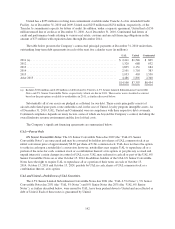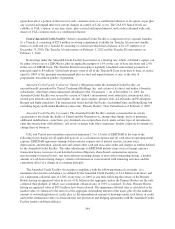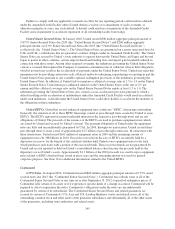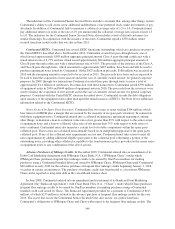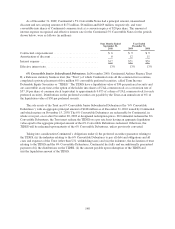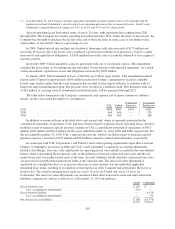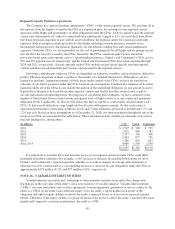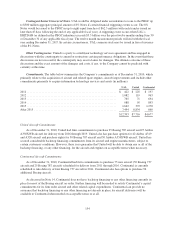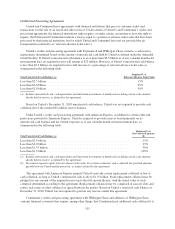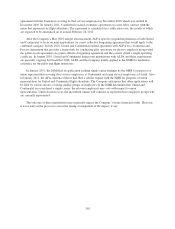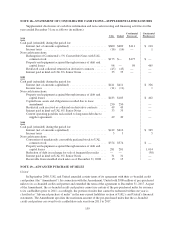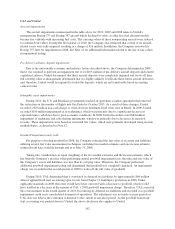United Airlines 2010 Annual Report Download - page 154
Download and view the complete annual report
Please find page 154 of the 2010 United Airlines annual report below. You can navigate through the pages in the report by either clicking on the pages listed below, or by using the keyword search tool below to find specific information within the annual report.If an entity is determined to be a VIE, the entity must be consolidated by the primary beneficiary. Under
new accounting standards applicable in 2010, the primary beneficiary is the holder of the variable interests that
has the power to direct the activities of a VIE that (i) most significantly impact the VIE’s economic performance
and (ii) has the obligation to absorb losses of or the right to receive benefits from the VIE that could potentially
be significant to the VIE. Prior to 2010, the determination of the primary beneficiary was based on projected cash
flows at the inception of the variable interests. Therefore, the Company must identify which activities most
significantly impact the VIE’s economic performance and determine whether it, or another party, has the power
to direct those activities.
The Company’s evaluation of its association with VIEs is described below:
Aircraft Leases. We are the lessee in a number of operating leases covering the majority of our leased
aircraft. The lessors are trusts established specifically to purchase, finance and lease aircraft to us. These leasing
entities meet the criteria for VIEs. We are generally not the primary beneficiary of the leasing entities if the lease
terms are consistent with market terms at the inception of the lease and do not include a residual value guarantee,
fixed-price purchase option or similar feature that obligates us to absorb decreases in value or entitles us to
participate in increases in the value of the aircraft. This is the case for many of our operating leases; however,
leases of approximately 11 United mainline jet aircraft and 75 Continental mainline jet aircraft contain a fixed-
price purchase option that allow United and Continental to purchase the aircraft at predetermined prices on
specified dates during the lease term. Additionally, leases covering substantially all of Continental’s 256 leased
regional jet aircraft contain an option to purchase the aircraft at the end of the lease term at prices that, depending
on market conditions, could be below fair value. The Company has not consolidated the related trusts because,
even taking into consideration these purchase options, the Company is still not the primary beneficiary. The
Company’s maximum exposure under these leases is the remaining lease payments, which are reflected in future
lease commitments in Note 15.
Airport Leases. Continental is the lessee of real property under long-term leases at a number of airports
where it is also the guarantor of approximately $1.7 billion of underlying debt and interest thereon. These leases
are typically with municipalities or other governmental entities, which are excluded from the consolidation
requirements concerning VIEs. To the extent Continental’s lease and related guarantee are with a separate legal
entity other than a governmental entity, Continental is not the primary beneficiary because the lease terms are
consistent with market terms at the inception of the lease and the lease does not include a residual value
guarantee, fixed-price purchase option or similar feature as discussed above. The leasing arrangements associated
with approximately $1.5 billion of these obligations are accounted for as operating leases, and the leasing
arrangements associated with approximately $190 million of these obligations are accounted for as capital leases.
Subsidiary Trust. Continental has a subsidiary trust that has mandatorily redeemable preferred securities
outstanding with a liquidation value of $248 million. The trust is a VIE because Continental has a limited ability
to make decisions about its activities. However, Continental is not the primary beneficiary of the trust. Therefore,
the trust and the mandatorily redeemable preferred securities issued by the trust are not reported in Continental’s
balance sheets. Instead, Continental reports its 6% Convertible Junior Subordinated Debentures held by the trust
as long-term debt and interest on these notes is recorded as interest expense for all periods presented in the
accompanying financial statements.
EETCs. The Company evaluated whether the pass-through trusts formed for its EETC financings, treated as
either debt or aircraft operating leases, are VIEs required to be consolidated by the Company under applicable
accounting guidance, and determined that the pass-through trusts are VIEs. Based on the Company’s analysis as
described below, the Company determined that it does not have a variable interest in the pass-through trusts.
The primary risk of the pass-through trusts is credit risk (i.e. the risk that United or Continental, the issuer of
the equipment notes, may be unable to make its principal and interest payments). The purpose of the pass-
through trusts is to enhance the credit worthiness of the Company’s debt obligation through certain bankruptcy
protection provisions, a liquidity facility (in certain of the EETC structures) and improved loan-to-value ratios for
152


